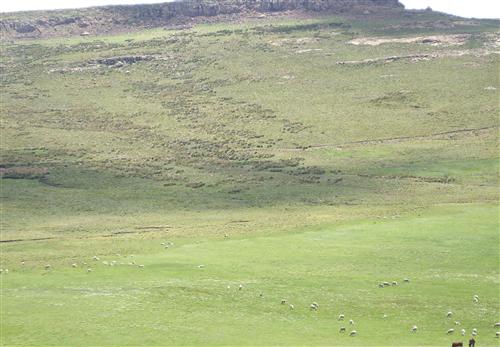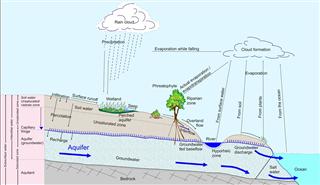The water and wetland resources of the Orange-Senqu River (especially in the Vaal and Upper Orange-Senqu sub-basins), provide numerous socio-economic development benefits to the riparian states, including among others.
-
Flow regulation
-
Erosion control
-
Flood plain farming
-
Plant and animal products
-
International recognition for conservation
-
Conservation
-
Tourism and recreation
-
Water Quality
-
Carbon Sinks
Therefore, careful and appropriate management is important to sustain the various sectors of the economy that depend on wetlands and their effect on water resources. Much of the population in the basin is concentrated near wetlands and many depend on associated springs and shallow wells for potable water.In addition to socio-economic benefits, wetlands can provide significant ecological benefits, including groundwater recharge and improved water quality.
Flow regulation
Besides serving as sources of streams, wetlands also regulate flow and attenuate floods. Flood-plains store water during the wet seasons, slowly releasing it throughout the dry periods. This helps to maintain flow in the perennial rivers of the basin and in some of their tributaries. This function of wetlands depends on a number of parameters: the size and shape of the wetland, number of wetlands located in a particular sub-basin or the entire basin, soil type and depth, and the vegetation in the wetland.
Erosion control and flood plain farming
Plants in marshes and swamps hold the soil and trap sediments in their roots. Wetlands therefore play an important role in flood control and erosion prevention. Well-vegetated rivers and floodplains are excellent flood wave absorbers. The deposited sediments and the variations in flooding create fertile soils that can be used to support subsistence floodplain farming. The pans in the Kalahari, the other forms of surface water bodies, are also important sources of livestock water and used for domestic purposes.
Plant and animal products
The nutrients in the wetland environment of the basin support diverse plant and animal species. Wetlands are principal habitats for fish species, providing cover as well as suitable breeding and feeding grounds. By southern African standards, the indigenous freshwater fish community of the Orange River is rather poor despite the river’s large size. Fifteen indigenous fish species have been recorded in the Orange River although one of these, Anguilla mossambica, is a rare vagrant that probably only occasionally traverses the river from eastern drainages. The Orange River fauna, as with other southern Cape rivers, is dominated (73%) by the family Cyprinidae (minnow, mudfish and yellow fishe) and seven species (50%) are endemic to the system (SAIAB website 2008). On the other hand, the Orange River Mouth is one of very few areas of sheltered shallow water along southern Africa’s arid Atlantic coastline, and it sustains important numbers of water birds (ORASECOM 2007e).
International recognition for conservation
The rich biodiversity and natural beauty of wetlands make them an important focus for conservation. Protected areas make up 4.7 % of the Orange-Senqu River basin (WRI 2008). Many of the national parks and conservation areas in the basin are wetlands which support large numbers of wetland birds of diverse species.
Threats to the Orange-Senqu basin wetlands include reduction of flows caused by droughts and water abstractions, aquatic weed infestation, application of pesticides and fertilisers, development of infrastructure such as dams, river water intake installations and bridges, over-exploitation of resources due to human pressure, abuse by uncontrolled fires, pollution and deforestation. Conservation efforts to minimize or avert threats to wetlands require both short- and long-term strategies.
Tourism and recreation
The wetlands sustain flow in the basin and support fish biodiversity. As a result tourism and fishing activities within the wetlands, as well as in the main river system and reservoirs, is very common. Due to the lack of dangerous animals and high water levels during summer, the river is also used for recreational canoeing particularly at the Orange River Mouth, on upper reaches of the river and in several reservoirs.

A wetland on the Motete River, Lesotho.
Source:Lesotho Water Commission 2008
( click to enlarge )
Groundwater Recharge
Depending on the soil, geology, and landscape of a wetland ecosystem, wetlands can contribute to groundwater recharge if water can filter down to the groundwater system. This function of wetlands can be very important where communities rely on groundwater resources for drinking water. Due to their storage capacity, wetlands often retain water during wet periods and release water during periods of drought, contributing to stream flow during these dry periods. See below for a conceptual diagram of the groundwater component of the water cycle.
 The role of groundwater in the water cycle. Source:CSIR 2004 ( click to enlarge ) |
Water Quality
Wetlands play an important role in improving surface water quality by filtering out suspended material (e.g., organic or inorganic sediments) and by retaining nutrients and pollutants. Both physical and chemical processes are important in this process. Wetland vegetation can help to trap suspended material, and the slower-moving or static waters in wetlands allow suspended particles (and any adsorbed chemicals) to settle out. Nutrients dissolved in water inflows can be used as resources by aquatic organisms or vegetation within the wetland, and can, along with pollutants and other chemicals, be chemically altered, stored within plants, or attached to wetland sediments. The benefits of water quality improvement to downstream ecosystems can include prevention of eutrophication, removal of water-borne pathogens and toxic chemicals, and protection of fish health and navigation routes as the load and deposition of suspended sediments is reduced. However, the processes responsible for water quality improvement can themselves be degraded by water pollution, depending on the specific characteristics of the soil, vegetation, and aquatic organisms and the nature of the water inflows.
Carbon Sinks
Many of the world’s wetlands contain peatlands, one of the most effective natural carbon sinks on the planet. If left intact, peatlands can sequester large voilumes of carbon from the atmosphere.
